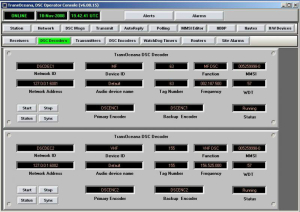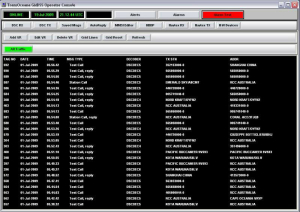DSC Decoder I
Features
- Can use existing or new radio receivers or transceivers
- Runs under Windows® operating system
- State of the art DSP signal processors
- Captures more DSC signals than any other decoder on the market
- Each decoder can service 2 radios
- Can support MF, HF and VHF radios simultaneously
- Up to 20 radios on a single PC
- No limit to the number of decoders on a network
- Parallel signal processors on each radio can capture message collisions
- A decoder can send messages to one or more operator consoles
- Internal memory to store up to 65,000 messages in case of network failures
- Passes all information down to the bit level on each message for subsequent processing
- Can decode the new expanded DSC sentences for enhanced position information
About

The TransOceana DSC decoder is a Windows® software application that runs on an industrial rack mount computer, a desktop computer or a laptop. The decoder is used to convert the DSC audio signals from a radio receiver into a digital DSC message and send the message to a GMDSS operator console on the same PC or over a local area network to one or more operator consoles. It uses an internal or external audio interface module (soundcard) to receive the radio audio signals. Each decoder can service two radios, radio 1 and radio 2. Radio 1 can be a MF or HF or VHF radio and Radio 2 can be a MF or HF or VHF radio. The radios do not have to be the same. Multiple decoders can be placed on a single PC to handle more radios. For example, an A3 station would run 3 decoders on the same PC:
Decoder 1: 2Mhz, 4Mhz
Decoder 2: 6Mhz, 8MHz
Decoder 3: 12Mhz, 16MHz
The number of decoders on a single PC is limited to the memory and CPU speed. We have tested systems successfully with as many as 14 DSC receivers on a single PC. Each decoder can be configured to send the DSC messages to one or more operator consoles on the network. The decoder is limited to a maximum of 100 operator console addresses.
Operator console

The DSC messages from the decoders are displayed on one or more operator consoles. The display can be filtered to show messages from selected decoders or from all decoders. If the network between the decoder and the operator console should fail, the decoder will continue to capture traffic and store it locally. When communications is restored the decoder will automatically update the console with all lost messages.
DSC decoder handler
The status of each decoder is displayed on the operator console using a DSC Decoder panel. Multiple decoders are stacked on top of each other in a manner similar to a 19″ equipment rack. The user can scroll up and down the stack to view the status of each decoder. The operator can temporarily suspend the operation of each decoder and restart it as required. The communication link between each decoder and operator console is monitored using a software watchdog timer. If the communication link fails an alarm is sounded to alert the operator.
DSC Decoder II
Features
- Black Box decoder
- Operator Console connection not required
- DSC messages are output using serial or UDP methods
- Can filter messages
- Can output to multiple destinations
- Can operate stand-alone as a DSC message recorder
- Ideal for decoding DSC traffic and passing to 3rd party software
About
The DSC Decoder II is a Windows® based software component for decoding DSC signals and passing the messages to 3rd party software using serial or UDP/IP connections. The standard DSC decoder requires connection to an operator console to view the messages. The DSC Decoder II does not require connection to an operator console. The DSC Decoder II is ideal for applications that require only DSC signal capture and reporting, e.g. receiving DSC message reports and passing the information to an AIS chart plotting system.
The DSC Decoder II is an integration of the standard TransOceana DSC decoder and the TransOceana GMDSS operator console. In the past if a 3rd party application wanted to capture DSC messages and report them on a web page or a chart they would need to purchase both a DSC decoder and GMDSS operator console software components. The DSC decoder would decode the signals and send them to the operator console. The operator console would use a virtual receiver to reformat the messages and send them to a 3rd party application using either AIS or NMEA protocols.
With the DSC Decoder II the decoder can send the DSC messages directly to the 3rd party application. There is no need for an operator console. However a DSC Decoder II can be configured to output DSC messages to BOTH 3rd party applications and one or more operator consoles if required.
The decoder can be configured to filter messages similar to a virtual receiver in the GMDSS operator console program. An operator console can have 10 virtual receivers and therefore 10 different filtering methods, the DSC Decoder II is limited to one filter per radio. If more than one filter is required then the decoder must pass its messages to a virtual receiver (operator console). The DSC Decoder II provides a less expensive solution for those applications requiring only DSC messages.
A DSC Decoder II can also be used as a stand alone DSC message recorder. The decoder can be configured to capture messages and store them into a report file to be accessed later by the user. For example, the decoder could be used to log all station calls to a specific MMSI.
